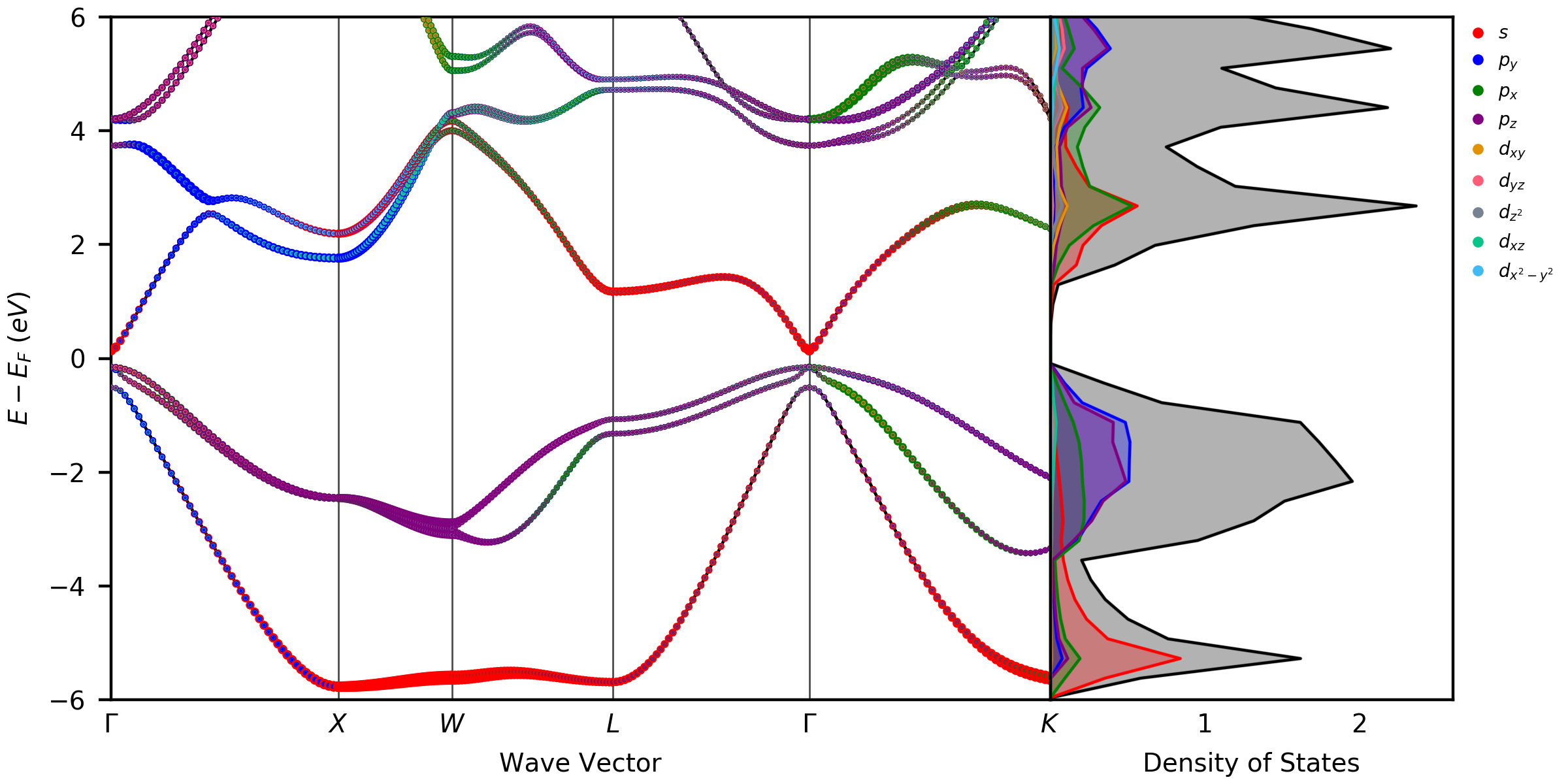A highly flexible and customizable library for visualizing electronic structure data from VASP calculations.
Find the full documentation here or by clicking the docs icon below.
This package was designed to give VASP users a flexible and easy to understand method for generating a wide variaty of band structures and density of states plots. There are four main modules in this package:
BandDosstandardutils
The Band and Dos modules allow for the highest level of flexibility because the user
needs to pass in their own matplotlib axis, letting the user completely design the
external appearence of their plot. The Band and Dos modules will then parse the
VASP output data and append the it to the axis.
The standard module uses the Band and Dos modules internally and
was designed for those people who are not familiar with matplotlib
or don't need to completely customize their own figure. There are a total of 48 different
styles of plots to choose from in this module. It gives the user the capability to project
onto any orbital, any atom, or any element in their structure, as well as individual orbitals
on any atom or element. There are also options for spin polarized band structures and density
of states as well, letting the user make intricate plots with only a few lines of code.
The utils module is used to generate files for band unfolding calculations.
pip install vaspvisfrom vaspvis import Band, Dos
# Non-HSE Calculation (plain band structure)
bs = Band(folder='path to vasp output folder')
# Band Calculation (projected band structure)
bs_projected = Band(folder='path to vasp output folder', projected=True)
# Density of states (projected or non-projected)
dos = Dos(folder='path to vasp output folder')Important Note: This package parses the EIGENVAL, PROCAR, KPOINTS, POSCAR, and INCAR files, be sure that they are in the folder you load into vaspvis.
Important Note: For spin projected orbitals you must load the spin up and spin down chanels separately using the spin = 'up' or spin = 'down' options with loading data. Default is spin = 'up'.
Band unfolding is useful for visualizing band structures of supercells and slab structures. The method used for calculating the band unfolded structure requires an integer transformation matrix from the bulk structure. To convert the slab structure so it has an integer matrix, the convert_slab function can be used to generate the new slab structure and also return the transformation matrix (M). More information about the band unfolding method can be found here
from vaspvis.utils import convert_slab
# This function returns and prints out the transformation matrix (M)
M = convert_slab(
bulk_path='POSCAR_bulk', # POSCAR of the primitive bulk structure
slab_path='POSCAR_slab', # POSCAR of the slab structure
index=[1,1,1], # Miller index of the given slab structure
)To generate the KPOINTS file for the band unfolded calculation the generate_kpoints function can be used
from vaspvis.utils import generate_kpoints
high_symmetry_points = [
[0.5,0.0,0.5], # X
[0.0,0.0,0.0], # Gamma
[0.5,0.0,0.5], # X
]
generate_kpoints(
M=M, # M can be generated with the convert slab function
high_symmetry_points=high_symmetry_points, # Special points
n=50, # Number of segments between each special point
)To plot the band structure the Band or standard module can be used. An example using the standard module is shown below.
from vaspvis import standard as st
band_folder = 'PATH_TO_VASP_FOLDER'
# Transformation matrix generated from convert_slab
M = [
[0,1,-1],
[1,-1,0],
[-8,-8,-8]
]
high_symm_points = [
[0.5, 0.0, 0.5], # X
[0.0, 0.0, 0.0], # Gamma
[0.5, 0.0, 0.5] # X
]
# All other functions in the standard library work with band unfolding too.
st.band_plain(
folder=band_folder,
erange=[-4,0],
unfold=True,
kpath='XGX',
high_symm_points=high_symm_points,
n=50,
M=M,
)from vaspvis import standard
standard.band_plain(
folder=band_folder
)from vaspvis import standard
standard.band_spd(
folder=band_folder
)from vaspvis import standard
standard.band_orbitals(
folder=band_folder,
orbitals=[0, 1, 2, 3, 4, 5, 6, 7, 8],
)from vaspvis import standard
standard.band_atoms(
folder=band_folder,
atoms=[0, 1],
)from vaspvis import standard
standard.band_atom_orbitals(
folder=band_folder,
atom_orbital_dict = {0:[1,3], 1:[1,7]}
)from vaspvis import standard
standard.band_atom_spd(
folder=band_folder,
atom_spd_dict={0:'spd'},
)from vaspvis import standard
standard.band_elements(
folder=band_folder,
elements=['In', 'As'],
)from vaspvis import standard
standard.band_element_spd(
folder=band_folder,
element_spd_dict={'As':'spd'},
)from vaspvis import standard
standard.band_element_orbitals(
folder=band_folder,
element_orbital_dict={'As':[2], 'In':[3]},
)from vaspvis import standard
standard.dos_plain(
folder=dos_folder,
energyaxis='x',
)from vaspvis import standard
standard.dos_spd(
folder=dos_folder,
energyaxis='x',
)from vaspvis import standard
standard.dos_orbitals(
folder=dos_folder,
orbitals=[0, 1, 2, 3, 4, 5, 6, 7, 8],
energyaxis='x',
)from vaspvis import standard
standard.dos_atoms(
folder=dos_folder,
atoms=[0, 1],
energyaxis='x',
)from vaspvis import standard
standard.dos_atom_orbital(
folder=dos_folder,
atom_orbital_pairs=[[0,1], [0,3], [1, 1], [1,7]],
energyaxis='x',
)from vaspvis import standard
standard.dos_atom_orbital(
folder=dos_folder,
atom_orbital_pairs=[[0,1], [0,3], [1, 1], [1,7]],
energyaxis='x',
)from vaspvis import standard
standard.dos_elements(
folder=dos_folder,
elements=['In', 'As'],
energyaxis='x',
)from vaspvis import standard
standard.dos_element_spd(
folder=dos_folder,
elements=['As'],
energyaxis='x',
)from vaspvis import standard
standard.dos_element_orbitals(
folder=dos_folder,
element_orbital_pairs=[['As', 2], ['In', 3]],
energyaxis='x',
)from vaspvis import standard
standard.band_dos_plain(
band_folder=band_folder,
dos_folder=dos_folder,
)from vaspvis import standard
standard.band_dos_spd(
band_folder=band_folder,
dos_folder=dos_folder,
)from vaspvis import standard
standard.band_dos_orbitals(
band_folder=band_folder,
dos_folder=dos_folder,
orbitals=[0, 1, 2, 3, 4, 5, 6, 7, 8],
)from vaspvis import standard
standard.band_dos_atom_orbital(
band_folder=band_folder,
dos_folder=dos_folder,
atom_orbital_pairs=[[0,1], [0,3], [1, 1], [1,7]]
)from vaspvis import standard
standard.band_dos_atoms(
band_folder=band_folder,
dos_folder=dos_folder,
atoms=[0, 1],
)from vaspvis import standard
standard.band_dos_elements(
band_folder=band_folder,
dos_folder=dos_folder,
elements=['In', 'As'],
)from vaspvis import standard
standard.band_dos_element_spd(
band_folder=band_folder,
dos_folder=dos_folder,
elements=['As'],
)from vaspvis import standard
standard.band_dos_element_orbitals(
band_folder=band_folder,
dos_folder=dos_folder,
element_orbital_pairs=[['As', 2], ['In', 3]],
)
























